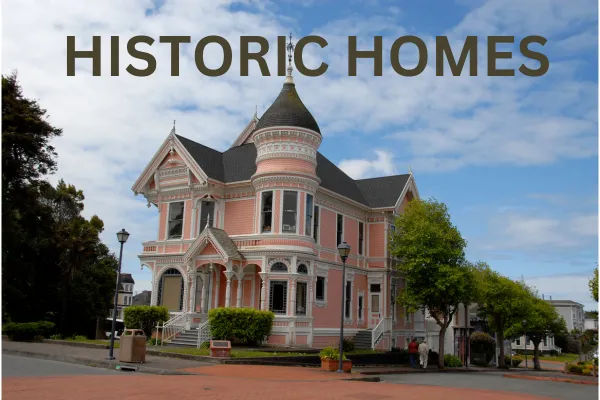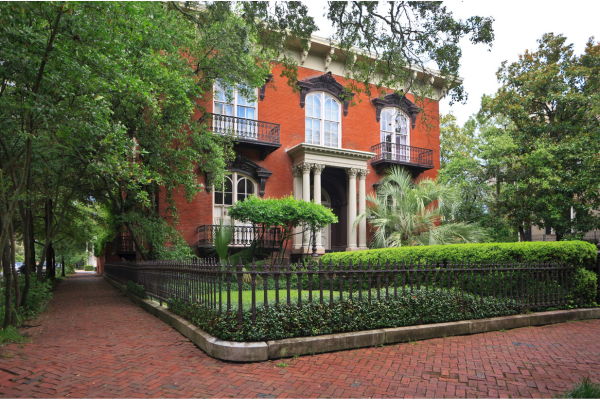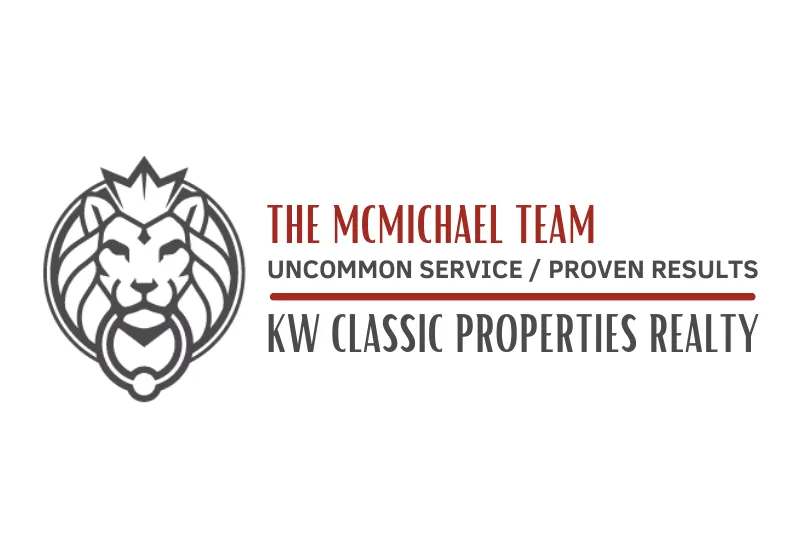Recent Posts

The Impact of Historic Preservation on Property Value
“Is it not cruel to let our city die by degrees, stripped of all her proud monuments, until there will be nothing left of all her history and beauty to inspire our children. If they are not inspired by the past of our city, where will they find the strength to fight for her future?” - Jacqueline Kennedy Onassis
Introduction:
Historical preservation extends beyond mere conservation efforts; it focuses on safeguarding our cultural heritage and architectural legacy. This article explores how designated historic districts and the preservation of their character influence property values, making them more than just fascinating relics.

A historically significant district, like German Village in Columbus, Ohio, can influence home prices, the local economy, and the overall appeal of these unique communities.
Understanding Historical Preservation
To understand the impact, it is important to grasp what historical preservation entails. It involves protecting and maintaining structures, objects, landscapes and artifacts that hold significant value to human history. Historic districts are areas recognized for their historical, cultural, or architectural importance.
The Allure of Historical Districts
Residing in a historic district often means living among charming, picturesque homes, with rich stories to share. These areas are characterized by tree-lined streets, vintage architecture, and an enduring sense of time that cannot be replicated in newer developments.
Property Value Appreciation
Historic preservation has a noticeable impact on property value appreciation. Homes located in historic districts tend to appreciate at a higher rate compared to those in non-historic neighborhoods. There are several reasons behind this phenomenon, including:
1. Limited Supply: Historic districts have a finite number of homes. They cannot be replicated with the same style or historical significance. This scarcity creates demand and can drives up prices.
2. Architectural Charm: The unique and visually pleasing architecture found in historic districts appeals to many homebuyers. Homes with intricate details, timeless designs and a touch of history can command higher prices.
3. Heritage and Stories: Properties with historical significance often come with stories attached to them. These stories captivate buyers creating an emotional connection that motivates them to pay a premium for a piece of history.
4. Convenient Location: Many historic districts are centrally located, offering access to amenities, cultural attractions, and transportation hubs. This desirable location adds value to the properties within these districts.
5. Tax Incentives: Government incentives like heritage property tax credits can significantly reduce the financial burden of owning and maintaining a historic home. These credits make homeownership in historic districts appealing, driving up demand, and subsequently increasing property values.
These various factors contribute together to enhance the value of properties within historic districts, making them sought-after places to live.
Attracting Heritage Tourism and Boosting Local Economy
Historic districts often draw heritage tourism, attracting visitors who appreciate the architectural and historic significance of the area. This increase in tourists helps boost the economy by benefiting businesses and indirectly boosting property values.
Challenges of Owning a Historic Home
Owning a home presents unique challenges. Maintenance costs can be higher due to the need for adherence to preservation guidelines. Furthermore, there may be restrictions on renovations requiring homeowners to strike a balance between preservation and modernization.
Benefits of Historic Tax Credits
Many governments provide tax incentives to property owners within historic districts. These tax credits help offset some of the expenses related to maintaining and renovating historic homes, making homeownership in these areas more appealing.
Balancing Preservation with Modernization
Finding the equilibrium between preserving historical authenticity and modernizing a home can be challenging. Many homeowners choose carefully planned renovations that preserve the property's character while incorporating modern amenities, creating a win-win situation.
The Appeal Factor
The charm and atmosphere of historic districts make them highly desirable places to live. Living in a neighborhood steeped in history and culture has a charm that can increase demand and property values.
Opportunities for Investing in Real Estate
Investors often see the potential in historic districts. Purchasing and renovating a historic property can yield significant returns, especially when the neighborhood experiences revitalization efforts, attracting more residents and businesses.
The Importance of Preserving Our History
As cities continue to grow and evolve, it remains crucial to prioritize the preservation of our historic sites. To ensure that historic districts continue to flourish, communities can adopt thoughtful urban planning and zoning regulations. This involves identifying areas suitable for growth while designating historic zones with strict preservation guidelines. Engaging with local stakeholders, including residents, developers, and historians, can foster a sense of shared responsibility for the district's well-being. Additionally, promoting educational programs and heritage tourism can instill a deeper appreciation for the historical value of these districts, encouraging ongoing preservation efforts. By embracing the past while embracing progress, communities can sustain the charm and cultural significance of their historic districts for generations to come.
Conclusion
Historic preservation extends beyond upkeep of buildings; it revolves around protecting our cultural heritage. The impact on property values serves as evidence of the enduring appeal of residing in historically significant areas. It serves as a reminder that our past indeed shapes our future.
FAQs (Frequently Asked Questions)
Do historic homes cost more to maintain?
While maintenance costs can be higher due to preservation requirements, tax incentives and the potential for property value appreciation often offset these expenses.Are there restrictions on renovating historic homes?
Yes, there are often restrictions in place to preserve the historical integrity of the property. Renovations must comply with preservation guidelines, ensuring the home's character is preserved.What are the tax benefits of owning a home in a historic district?
Many governments offer tax credits to incentivize historic property ownership. These credits can reduce the overall cost of owning and maintaining a historic home, making it more financially feasible.Can I modernize a historic home while preserving its character?
Yes, it's possible to modernize a historic home while preserving its character. Careful planning and adherence to preservation guidelines are key to achieving this delicate balance.Do all historic districts experience property value appreciation?
While many historic districts see property value appreciation, it can vary based on location, demand, and local economic factors. However, the unique charm of these areas often makes them desirable places to live, contributing to appreciation over time.
Recent Posts

The Impact of Historic Preservation on Property Value
“Is it not cruel to let our city die by degrees, stripped of all her proud monuments, until there will be nothing left of all her history and beauty to inspire our children. If they are not inspired by the past of our city, where will they find the strength to fight for her future?” - Jacqueline Kennedy Onassis
Introduction:
Historical preservation extends beyond mere conservation efforts; it focuses on safeguarding our cultural heritage and architectural legacy. This article explores how designated historic districts and the preservation of their character influence property values, making them more than just fascinating relics.

A historically significant district, like German Village in Columbus, Ohio, can influence home prices, the local economy, and the overall appeal of these unique communities.
Understanding Historical Preservation
To understand the impact, it is important to grasp what historical preservation entails. It involves protecting and maintaining structures, objects, landscapes and artifacts that hold significant value to human history. Historic districts are areas recognized for their historical, cultural, or architectural importance.
The Allure of Historical Districts
Residing in a historic district often means living among charming, picturesque homes, with rich stories to share. These areas are characterized by tree-lined streets, vintage architecture, and an enduring sense of time that cannot be replicated in newer developments.
Property Value Appreciation
Historic preservation has a noticeable impact on property value appreciation. Homes located in historic districts tend to appreciate at a higher rate compared to those in non-historic neighborhoods. There are several reasons behind this phenomenon, including:
1. Limited Supply: Historic districts have a finite number of homes. They cannot be replicated with the same style or historical significance. This scarcity creates demand and can drives up prices.
2. Architectural Charm: The unique and visually pleasing architecture found in historic districts appeals to many homebuyers. Homes with intricate details, timeless designs and a touch of history can command higher prices.
3. Heritage and Stories: Properties with historical significance often come with stories attached to them. These stories captivate buyers creating an emotional connection that motivates them to pay a premium for a piece of history.
4. Convenient Location: Many historic districts are centrally located, offering access to amenities, cultural attractions, and transportation hubs. This desirable location adds value to the properties within these districts.
5. Tax Incentives: Government incentives like heritage property tax credits can significantly reduce the financial burden of owning and maintaining a historic home. These credits make homeownership in historic districts appealing, driving up demand, and subsequently increasing property values.
These various factors contribute together to enhance the value of properties within historic districts, making them sought-after places to live.
Attracting Heritage Tourism and Boosting Local Economy
Historic districts often draw heritage tourism, attracting visitors who appreciate the architectural and historic significance of the area. This increase in tourists helps boost the economy by benefiting businesses and indirectly boosting property values.
Challenges of Owning a Historic Home
Owning a home presents unique challenges. Maintenance costs can be higher due to the need for adherence to preservation guidelines. Furthermore, there may be restrictions on renovations requiring homeowners to strike a balance between preservation and modernization.
Benefits of Historic Tax Credits
Many governments provide tax incentives to property owners within historic districts. These tax credits help offset some of the expenses related to maintaining and renovating historic homes, making homeownership in these areas more appealing.
Balancing Preservation with Modernization
Finding the equilibrium between preserving historical authenticity and modernizing a home can be challenging. Many homeowners choose carefully planned renovations that preserve the property's character while incorporating modern amenities, creating a win-win situation.
The Appeal Factor
The charm and atmosphere of historic districts make them highly desirable places to live. Living in a neighborhood steeped in history and culture has a charm that can increase demand and property values.
Opportunities for Investing in Real Estate
Investors often see the potential in historic districts. Purchasing and renovating a historic property can yield significant returns, especially when the neighborhood experiences revitalization efforts, attracting more residents and businesses.
The Importance of Preserving Our History
As cities continue to grow and evolve, it remains crucial to prioritize the preservation of our historic sites. To ensure that historic districts continue to flourish, communities can adopt thoughtful urban planning and zoning regulations. This involves identifying areas suitable for growth while designating historic zones with strict preservation guidelines. Engaging with local stakeholders, including residents, developers, and historians, can foster a sense of shared responsibility for the district's well-being. Additionally, promoting educational programs and heritage tourism can instill a deeper appreciation for the historical value of these districts, encouraging ongoing preservation efforts. By embracing the past while embracing progress, communities can sustain the charm and cultural significance of their historic districts for generations to come.
Conclusion
Historic preservation extends beyond upkeep of buildings; it revolves around protecting our cultural heritage. The impact on property values serves as evidence of the enduring appeal of residing in historically significant areas. It serves as a reminder that our past indeed shapes our future.
FAQs (Frequently Asked Questions)
Do historic homes cost more to maintain?
While maintenance costs can be higher due to preservation requirements, tax incentives and the potential for property value appreciation often offset these expenses.Are there restrictions on renovating historic homes?
Yes, there are often restrictions in place to preserve the historical integrity of the property. Renovations must comply with preservation guidelines, ensuring the home's character is preserved.What are the tax benefits of owning a home in a historic district?
Many governments offer tax credits to incentivize historic property ownership. These credits can reduce the overall cost of owning and maintaining a historic home, making it more financially feasible.Can I modernize a historic home while preserving its character?
Yes, it's possible to modernize a historic home while preserving its character. Careful planning and adherence to preservation guidelines are key to achieving this delicate balance.Do all historic districts experience property value appreciation?
While many historic districts see property value appreciation, it can vary based on location, demand, and local economic factors. However, the unique charm of these areas often makes them desirable places to live, contributing to appreciation over time.

1349 W. Lane Ave, Suite 1125, Columbus, OH, 43221
(614) 769-7766
(614) 768-6531
www.livingincolumbus.com





